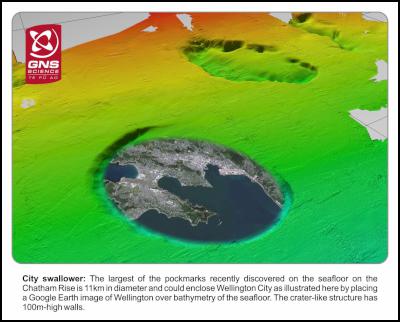Scientists Find Mysterious Giant Pockmarks on Chatham Rise
MEDIA RELEASE from GNS Science, 2 APRIL 2013
Scientists Find Mysterious Giant
Pockmarks on Chatham Rise
New Zealand, German and American scientists have found what may be the world’s biggest pockmarks on the seafloor of the Chatham Rise, about 500km east of Christchurch.
Pockmarks are crater-like structures on the seafloor caused by fluids and gases erupting through sediments into the ocean.

Three giant pockmarks, the largest being 11km by 6km in diameter and 100m deep, are possibly twice the size of the largest pockmarks recorded in scientific literature. Scientists believe they are the ancient remnants of vigorous degassing from under the seafloor into the ocean.
The structures are at water depths of about 1000m and there is currently no sign of gas being emitted from them.
They are part of a much larger field of many thousands of smaller pockmarks that extends eastward along the Chatham Rise for several hundred kilometres from Banks Peninsula. This vast field covers an estimated 20,000km of seafloor.
An international group of scientists investigated the larger seafloor structures on the German research ship Sonne recently. Their aim was to determine the geological origin of the structures, which were first noted in 2007.
“Some of the pockmarks on the Chatham Rise are huge compared to similar structures observed elsewhere in the world,” said GNS Science marine geophysicist Bryan Davy, one of the scientists who took part in the research voyage.
“It’s most unusual for scientists to encounter seafloor structures of this size and complexity. They are big enough to enclose the Wellington city urban area, or lower Manhattan,” Dr Davy said.
The discovery indicated that there was still a lot to learn about the ocean floor off the New Zealand coast.
The geological processes that led to the formation of the larger structures were still unclear, but survey leader on the Sonne,Joerg Bialas from GEOMAR Helmholtz Centre for Ocean Research in Kiel, Germany, said there were clear indications in seismic reflection records of gas pockets and fluid flow structures in the deeper sediments underneath the pockmarks.
“The pockmark features are covered by complex layers of more recent sediment,” Dr Bialas said.
Gas release from the larger pockmarks may have been sudden and possibly even violent, with a massive volume being expelled into the ocean and atmosphere within hours or days.
Scientists cannot rule out volcanic activity, directly or indirectly, having caused the release of gas. Another possibility is the release of sub-seafloor hydrocarbon gas through a layer of gas hydrate deposits. This would have coincided with drops in sea level of about 100m during ice ages and subsequent warming of sea temperatures.
Gas hydrate scientist Ingo Pecher, of The University of Auckland, said while there was no sign of active gas systems in the larger pockmarks, the smaller ones in shallower water appeared to have been sporadically active.
“Gas escape could be occurring from the smaller pockmarks during glacial intervals every 20,000 or 100,000 years,” said Dr Pecher, who has a Marsden research grant to investigate gas systems under the seafloor of the Chatham Rise.
“Methane is a potent greenhouse gas and the escape of big volumes would have significant implications for climate change and ocean acidification,” he said.
The research has global implications because the episodic and cumulative release of greenhouse gases into the ocean and atmosphere in the geological past would have contributed to episodes of global warming.
Scientists from Germany, USA and New Zealand will continue to analyse the large amounts of seismic data and sediment samples collected during the voyage to clarify the history of the enigmatic structures.
Scientists involved in this project are from GEOMAR Helmholtz Centre for Ocean Research in Germany, GNS Science, The University of Auckland, Otago University, NIWA, and the US Naval Research Laboratory.
ENDS


 Bill Bennett: Satellite TXT expands, how Egmont Village got a fibre network
Bill Bennett: Satellite TXT expands, how Egmont Village got a fibre network Community Access Media Alliance: Proposed Spectrum Fee Increases Threaten New Zealand’s Community Access Media Sector
Community Access Media Alliance: Proposed Spectrum Fee Increases Threaten New Zealand’s Community Access Media Sector Brewers Association: Brewers Association Of New Zealand Supports Modernisation Of Alcohol Legislation
Brewers Association: Brewers Association Of New Zealand Supports Modernisation Of Alcohol Legislation Commerce Commission: ComCom Warns Of Pyramid Schemes After South Auckland Scammers Plead Guilty
Commerce Commission: ComCom Warns Of Pyramid Schemes After South Auckland Scammers Plead Guilty MBIE: MBIE Publish Mid-Point Review Of The Phase-Out Of The Low Fixed Charge (LFC)
MBIE: MBIE Publish Mid-Point Review Of The Phase-Out Of The Low Fixed Charge (LFC) Science Media Centre: Company Claims To Have “De-Extincted” The Dire Wolf – Expert Reaction
Science Media Centre: Company Claims To Have “De-Extincted” The Dire Wolf – Expert Reaction



